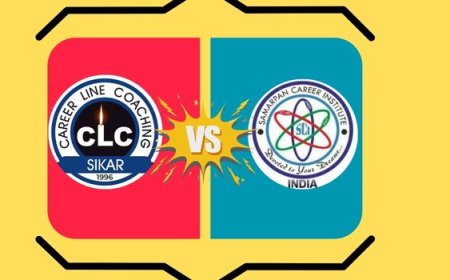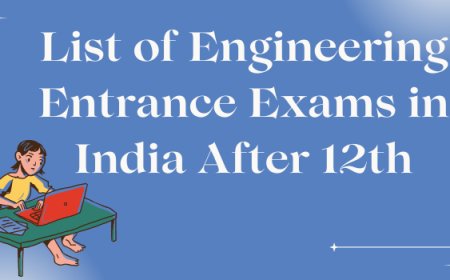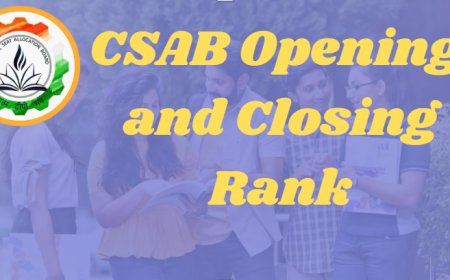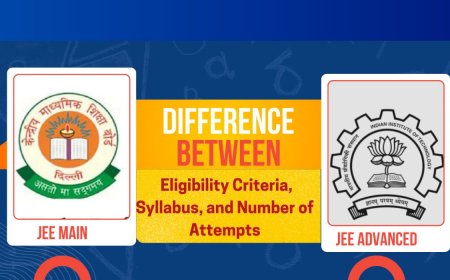IIT vs NIT: Key Differences ,Number of Institutes, Admission, Ranking & Cutoff
Compare IIT vs NIT on key factors like ranking, number of institutes, admission process, seat intake & JEE cutoff in this detailed guide.

The selection process between Indian Institutes of Technology and National Institutes of Technology represents a standard argument among Indian engineering students. India houses these two premier engineering institutions as its most competitive and demanded learning institutions. The institutions provide remarkable educational standards as well as career possibilities yet they maintain substantial differences between their ranking system and admission protocols together with the number of participating colleges and admission requirements. To pursue studies at NITs students need a successful performance in JEE Main 2025 but obtaining entry into IITs requires students to pass JEE Main 2025 before moving forward to sit for JEE Advanced 2025.
In this article, we will discuss the key differences between IITs and NITs, total number of institutes, admission process, rankings, and JEE Main 2025 cutoff to help you make an informed decision about your engineering future.
Difference between IIT and NIT
There exists four major distinctions between IITs and NITs which relate to their facilities as well as their teaching staff size and lab capabilities. The number of institutions within IITs stays low while these colleges tend to possess modern facilities which connect them to international partners. NITs reach more locations throughout the country to provide students enhanced regional availability and predictable academic quality standards.
This text examines the major distinctions between IITs and NITs as well as providing guidance for selecting the proper engineering institution.
|
Features |
IIT |
NIT |
|
Full Form of Institute |
Indian Institutes of Technology |
National Institutes of Technology |
|
Number of Institutes |
23 |
31 |
|
Difficulty level of selection |
Tough |
High |
|
Entrance Exam |
JEE Advanced |
JEE Main |
|
Faculty |
Most qualified and research-oriented and Most IIT professors hold Ph.D. degrees |
Experience teachers and Only few holds PHD degree |
|
Ranking |
Top ranked Nationally and Globally. |
Nationally Rank |
|
Placements |
Higher, average and International package |
Strong domestic placements |
|
Industry Exposure |
Expensive |
Average |
|
Infrastructure |
World class faculty with Modern furniture campus |
Excellent in top Nits |
|
Fees |
Approx 8 LPA to 12 LPA (4 YEARS) | Approx 3 LPA to 5 LPA (4 YEARS) |
What is IIT vs NIT?
IIT Full Form:
The Indian Institutes of Technology (IITs) introduced their first academic institution at Kharagpur during 1951. The existing number of Indian Institutes of Technology amounts to 23 institutes while B.Tech programs have a total supply of 17,000 seats for undergraduate candidates in India. IITs receive fame from their challenging academic standards combined with world-leading research production and skilled teaching staff. The top IITs which include IIT Madras and IIT Delhi and IIT Bombay and IIT Kanpur hold spots in worldwide best institution rankings and report remarkable placement results by paying out an average salary starting at ₹15–25 LPA for Computer Science Engineering and other similar branches. These educational institutions welcome the most respected international recruiting organizations to provide students with diverse professional opportunities across sectors.
NIT Full Form:
The National Institutes of Technology (NITs) established their first institute at NIT Warangal that Founded in 1959 through its former name REC. The present number of NITs in India reaches 31 with 24,000 available B.Tech undergraduate seats for students. The educational institutions NIT Trichy and NIT Surathkal together with NIT Warangal and NIT Calicut maintain famous reputations through their impressive academic standards and outstanding physical infrastructure and regular placement success. Students from these educational institutions find good placements through their industrial collaborations and earn between ₹8-15 LPA annually in fields like Computer Science and Engineering.
IIT VS NIT : Total Number of Institutes
IITs differ from NITs through their infrastructure features together with their faculty standards and research capabilities and number of educational centers. The total number of IITs remains lower than other institutions as these colleges maintain higher standards of facilities in addition to international academic partnerships. The IIT holds 23 institutes in India that give a total 17,000 seats for undergraduate students.
Because NITs cover larger geographical areas they provide accessible locations throughout the regions with stable academic measures across all campuses. As India's leading technical education institutions IIT (Indian Institute of Technology) together with NIT (National Institute of Technology) were set up for advancing engineering excellence. The NIT contains 31 institutes in India. Here the list of TOP IIT and NIT colleges institute names:
|
IIT Madras |
NIT Warangal |
|
IIT Kharagpur |
NIT Trichy |
|
IIT Delhi |
NIT Surathkal |
|
IIT Bombay |
NIT Calicut |
|
IIT Goa |
NIT Silchar |
|
IIT Kanpur |
NIT Jaipur |
|
IIT Ropar |
NIT Raipur |
|
IIT Roorkee |
NIT Goa |
|
IIT Guwahati |
NIT Durgapur |
|
IIT Patna IIT Jodhpur |
Dr. B.R.Ambedkar NIT Jalandhar |
|
IIT Hyderabad |
NIT Hamirpur |
|
IIT Tirupati |
NIT Jamshedpur |
|
IIT Indore |
NIT Patna |
|
IIT Dhanbad |
NIT Manipur |
|
IIT BHU |
NIT Sikkim |
IIT VS NIT: Admission Process
IIT Admission:
Candidates must pass the JEE Advanced stage even though they need to be among the top 2.5 lakh rankers from JEE Main examinations.
After JEE Advanced results students enter the colleges through JoSAA Counselling.
Candidates must prove their merit because the admission process retains absolute equality-based selection along with extremely challenging competition.
NIT Admission:
The admission process at both institutes depends exclusively on JEE Main exam result.
The admission process through JoSAA Counselling uses JEE Main rank as the selection criterion.
Candidates must succeed in the state quota (50 percent) and the all-India quota (50 percent).
The admission process for IITs demands two stages of tests including both JEE Main and JEE Advanced whereas NITs grant admission through JEE Main alone.
IIT VS NIT : NIRF Ranking 2025
IIT NIRF Ranking 2025
Globally and nationally top 10 IIT Colleges in India with NIRF Ranking. The institutions IIT Bombay and IIT Delhi together with IIT Madras appear regularly in both QS World Rankings and NIRF top 10.
|
College Name |
NIRF Rank |
|
IIT Madras |
1 |
|
IIT Delhi |
2 |
|
IIT Bombay |
3 |
|
IIT Kanpur |
4 |
|
IIT Kharagpur |
5 |
|
IIT Roorkee |
6 |
|
IIT Guwahati |
7 |
|
IIT Hyderabad |
8 |
|
IIT BHU |
9 |
|
IIT Dhanbad |
10 |
These institutions emphasize innovative research while maintaining quality teaching staff and successful international working relationships.
NIT NIRF Ranking 2025
There are some of the highly reputed colleges in India. The National Institutional Ranking Framework positions the education institutions NIT Trichy, NIT Surathkal, and NIT Warangal in the 15th to 20th rankings regularly.
|
College Name |
NIRF Rank |
|
NIT Tiruchirappalli (NIT Trichy) |
9 |
|
NIT Rourkela |
16 |
|
NIT Surathkal |
21 |
|
NIT Warangal |
26 |
|
NIT Calicut |
32 |
|
NIT Durgapur |
34 |
|
NIT Silchar |
35 |
|
NIT Kurukshetra |
38 |
|
NIT Jalandhar |
40 |
|
NIT Jamshedpur |
41 |
The IITs lead the ranking system with their extensive infrastructure and notable alumni network that exceeds that of NITs.
Apart from their quality institutions, IITs maintain a distinct advantage in scholarly reputation and their status as top national research institutions and globally recognized programs.
Read More: List of NIT Colleges in India 2025 : NIRF Ranking, Fees and Packages
IIT vs NIT Cutoff Trends
The cutoff requirements differ between IITs and NITs since they are dependent on the specific branch combined with category and academic institution. The higher difficulty in competition at IIT institutions causes their cutoff standards to surpass those of NIT institutions.
IIT Cutoff Example (General Category)
The Computer Science Engineering course at IIT Bombay secured positions from first to seventieth in the annual rankings (achieved scores of 320+ out of 360 in the JEE Advanced exams).
-
IIT Delhi EE: AIR 100–500
-
IIT Madras ME: AIR 800–1500
NIT Cutoff Example (General Category Home State Quota):
-
NIT Trichy CSE: JEE Main Rank 1500–2500
-
NIT Surathkal ECE: Rank 3000–5000
-
NIT Warangal ME: Rank 6000–8000
Both IITs along with NITs possess substantially reduced cutoff scores for their reserved category seats.
IIT VS NIT : Which One Should You Choose?
Students with solid JEE Advanced ranks pick IITs since these institutions maintain better international recognition and hold distinguished teaching talent while their alumni network supports graduates and provide great placement benefits in Computer Science and Electrical Engineering. The educational system at NITs provides strong placement opportunities with quality instruction however IITs provide better research potential and innovation possibilities through their international connections. Your career path as an engineer will begin more swiftly if you choose to study at an IIT.
Conclusion
Both the institutions of IITs and NITs function as technical education institutions in India which offer different advantages to their student body. National Institutes of Technology excel in student placement opportunities alongside offering easier accessibility and numerous educational choices even though Indian Institutes of Technology own superior international accreditation status.
Look for an educational institution that matches your educational level through providing programs based on your interests together with career goals. A student who takes advantage of their educational opportunities at IIT or NIT will achieve engineering career success. If your dream is to study at a top IIT College in India, then start your journey with CLC Sikar.
What's Your Reaction?































